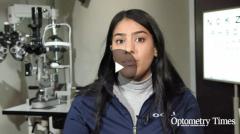
The Technician’s Role
Episodes in this series

Ileana Abreu describes approaches taken by OCLI technicians for dry eye screening, counseling patients about branded versus generic medications, and addressing medication cost and substitution concerns.
[Transcript]
Ileana Abreau, OSC, COA: My name is Ileana Abreau. I’m the technical supervisor at Ophthalmic Consultants of Long Island as a certified ophthalmic assistant, where I’ve been working for approximately 8 years.
Every patient who comes in the door gets screened for dry eye. We ask a series of questions such as, “Are you irritated? Do you feel foreign body sensation? Are your eyes tired throughout the day? Are they irritated? Is your vision blurry?” Depending on the answers, we’ll perform a series of tests, such as tear osmolarity, InflammaDry, a Schirmer test, to determine whether they have dry eye.
When a physician decides to start a patient on medication, we discuss the expectations with the patient, how long it’s going to take for them to feel some relief. Sometimes it can take up to 2 weeks. Sometimes it can take up to 3 months. We discuss with the patient the instructions for use—once a day, twice a day, 4 times a day—and how long to space [between drops]. Sometimes it’s important to space medications 5 minutes to 15 minutes between each drop. Some patients are on multiple medications.
We inform the patients of the importance of returning for their follow-up appointment to see their results and to make sure that they’re responding to the medication that the physician started them on.
With dry eye medication, one of the most important things is spacing the medication because there are multiple medications at once. If patients are putting in drops and putting in drops, they’re just washing one out with the other. With some medications, like Restasis, you have to wait 15 minutes in between before you administer another drop.
Brand name medication is a very important topic of discussion when it comes to patients because they [the clinician] wants to make sure that they’re getting the best medication that’s out there for them. [Practitioners] always start with prescribing the brand name medication versus the generic medication. We discuss with patients the importance of using the brand name medication versus the generic. We tell them that the studies have shown that for efficacy, the brand name medication has shown better results.
One concern for dry eye patients is the cost of their medications. We discuss with patients the options that they have. A lot of the pharmaceutical companies have patient assistance programs. We discuss GoodRx [website for tracking prescription drug prices and discounts]. We find samples to get patients started at least for the first month so they can start to see the results, and that will encourage them to want to pay for a medication.
There are also coupons available that we always have in the office. We give them to the patients, and we have rebates. We’re always searching or finding ways for patients to be able to afford their medications.
We frequently get calls from pharmacies attempting to switch patients from brand name medications to generics for multiple reasons. It could be cost, it could be that the prescription is not covered by the patient’s insurance. It could be that the pharmacy just wants us to encourage the patients to switch to a generic.
Unfortunately, dry eye medications don’t have generic substitutes, but a lot of other medications do. With glaucoma medications or a lot of our surgical drops, we’re often being encouraged to switch patients to the generic medications. We always encourage the patient to go for the brand medication first. But obviously based on the patient’s financial situation, we work to determine what the best course of action would be, whether it is a patient who we should switch to a generic or it’s a patient who we’ll encourage to get the brand name medication.
Newsletter
Want more insights like this? Subscribe to Optometry Times and get clinical pearls and practice tips delivered straight to your inbox.
























































.png)


